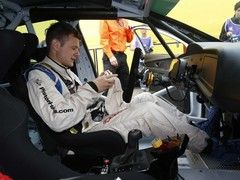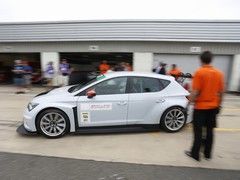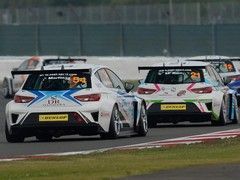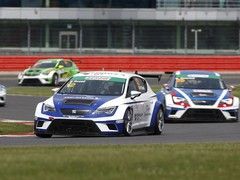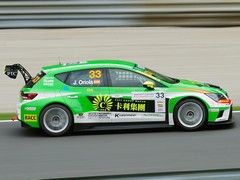SEAT Leon Cup Racer: Driven
Cold slicks, Silverstone GP, three laps; a brief but memorable taste of SEAT's new racing car [Vid added]
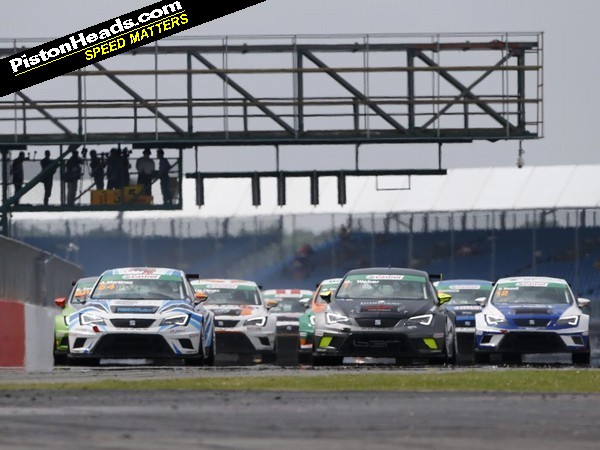
"God, that looks flippin ace" is my first utterance on seeing the Cup Racer in the metal. Or something along those lines. It's low, really low, the negative camber of the front wheels adding to the fantastic stance. There are myriad vents, a deeper splitter and a real sense of purpose about the front. The rear too is a treat with the obscenely distended arches there housing massive wheels, the de rigueur wing (this is a FWD racing car after all) and an exceptionally cool centre-exit exhaust.
But then you see it in profile and the Cup Racer is a bit, well, odd. Five doors has the effect of elongating the wheelbase, the rear spoiler seems strangely placed and those arches can look a bit OTT. Notice on both the road car and Eurocup that the door handles look very low; on the Cupra a roadgoing ride height makes them less noticeable but they make the Cup Racer seem a bit droopy as it's so ground hugging. Weird. It certainly doesn't want for presence though.
Stop, spanner time
Any thoughts on aesthetics are soon discarded once inside though. The driving position is just superb. The affable spanner wielding SEAT technicians wanted me to arrive in plenty of time for a seat fitting, only for me to drop in and find an ideal position already there. They almost seemed disappointed.
Where you sit too high in the Cupra (and that's not simply clouded by a racing car, that's by road car standards), the Cup Racer places your bum down and eyes peering out just above the the dash. The steering wheel comes out and up and the digital dash is a paragon of clarity. All the info that would ever be required (plus probably a lot more) clearly and easily displayed. The wheel itself is gorgeous; skinny, Alcantara and just lovely.
"Flick the red switch, then the amber switch and then this red button on the wheel" are the starting instructions. Red sw... what's this? Having been so absorbed in the wheel and dash display, the gearlever had gone pretty much unnoticed. It's just the Cupra DSG gear selector, identical to the road car's. Plonked there amongst ignition switches, a fire extinguisher button and a roll cage it doesn't half look bizarre. Still, no obstreperous sequential clutch to deal with at least.
What was that?
Agh! It's loud. Having watched the Eurocup Saturday race I foolishly believed the noise wouldn't come as a shock. Idiot. Reverberating around the barren interior, the noise at idle is an angry and harsh buzz. Given it's so closely related to the road car engine (the 50hp gain is through mapping, intake and exhaust tweaks, with no internal mods), the Cup Racer feels a million miles away at idle. SEAT has done a good job of imbuing the car with some real racer low-rpm grumpiness. Works well for the intimidation factor
Out on the circuit and with a few revs, the car feels much happier. And very, very fast. The road car itself is already a fairly rapid thing but shorn of around 200kg, bolstered by another 50hp and with all that racket it feels on another level entirely. Again, it probably shouldn't have been as surprising.
The shift lights begin at 6,000rpm, the red ones illuminating very soon after to signal the impending 6,600rpm limiter. Where in the road car it can be detected which gear you're in fairly easily, the Eurocup seems to be accelerating in fifth as strongly as third. Of course some of that will be down to the higher rev ranges you're in on track but up to about 110mph it's more than fast enough for this middle-ranking Academy driver, thanks.
Familiarity breeds...
If seeing the DSG selector in the cabin looked a little incongruous inside, its influence on the driving experience is similarly at odds with the Cup Racer's appearance. Going up the gears is just fine, the shifts rapid and with enough flatulence from the exhaust to make the Cupra sound rather demure. It does the racing car thing there very well but less successfully going back down. It just lacks that instantaneous response found in a sequential box for last second downchanges, the rev blip feeling like it's robbing you of some time and another gear. The paddles themselves are a little disappointing also, quite small and only clicking through the gears where something more substantial in terms of size and travel would probably be preferential. I'm only assuming there, a racing driver I certainly am not.
The Leon Cupra won't allow much left-foot braking, with a shoe on both pedals killing power, often at the most inopportune time. Obviously that couldn't happen in a racing car and it's nice to report the Eurocup has the most fabulous, feelsome, powerful brakes. The front discs are 22mm larger in diameter than the road car and grasped by six-piston calipers, their efforts augmented by that drastically lower kerb weight.. The left floor-hinged pedal needs a decent push but there's travel to it once accustomed. Furthermore, the effort is entirely commensurate with how the car sheds speed. Perhaps that sounds a bit daft but there's a real sense of control and confidence with how the Eurocup slows. There's no second guessing inputs or fear of locking up either. Perhaps I wasn't trying hard enough.
You've probably noticed there's no mention of how the Leon Eurocup handles yet. That's because, on the first lap, I had quite a big spin and so probably didn't push quite as hard following that. I fully expect to be rightly chastised for it but there is some justification (and most definitely not an excuse. Honest). SEAT's test driver Jordi Gene had warned that cold rear slicks are a little sketchy and that he would be taking it easy through the first few corners. But of course racing driver 'taking it easy' is markedly different to the procedure mere mortals would go through.
Keep your foot in
Jordi's car had a camera mounted on the back, recording 'my' car for your viewing pleasure and so I was keen to stick with him. He pelted off towards Maggots and Becketts really very fast indeed. I followed his line through the left but must have lifted at the wrong point going right. Feel free to laugh in full screen HD below. I've never been so glad to be in a car without a clutch pedal.
Anyway, what that had made apparent and the next corners emphasised is that you do not lift in a SEAT Leon Cup Racer. Much like the road car, it's attitude is dictated by the front end but whereas that can feel it's pivoting around your ankles, the Eurocup seems to be through your hips, if not slightly behind. You'll see also in the video a few instances of the car oversteering past corner entry. I am without the talent to fully exploit it but you sense the car is at its best being nailed on the brakes to the apex, that mobile rear keeping the nose on line and your right foot already planted to pull it out the other side. With no lifting to upset the front led balance. Moron.
Through some of Silverstone's longer corners the differential lock can be felt doing its thing as you get on the power what feels like horribly prematurely only to have it battle through the understeer and pull the car out. Being so much lighter than the road car every response is so sharp and the electrically assisted power steering is far better in feel and response than you may think. With a little more time (and a huge trough more talent), the Cup Racer is probably a car in which a fast rhythm could be established. Make allowances for the gearbox, exploit the flightiness rather than be overawed by it and have a lot of fun. Indeed, having watched the race and some Eurocup highlights, the drivers certainly aren't afraid to get stuck in.
Contributing to that must be the Cup Racer's relative affordability. The Eurocup costs 70,000 euros plus taxes with fees for the six rounds across Europe costing 12,000 euros. And running (very nearly) a road car engine and gearbox must reduce maintenance costs significantly. All very tempting. Furthermore, you only need to look at the success of those drivers who have triumphed in championships like the Clio Cup and F3 to see that fast drivers in single makes series are fast drivers full stop. So the Eurocup could be an alternative stepping stone into a big time touring car spot. Indeed the only thing that could possibly hold the Eurocup back for aspiring racers is that an M235i Racing is reasonably affordable as motorsport cars go too. What a decision to have to make.
SEAT LEON CUP RACER
Engine: 1,984cc four-cylinder turbo
Transmission: 6-speed DSG, front-wheel drive
Power (hp): 330
Torque (lb ft): 258
0-62mph: 5 secs (estimate)
Top speed: 160mph
Weight: c.1,150kg
MPG: NA
CO2: NA
Price: From 70,000 euros

Once the tyres were a bit warmer was it 'relatively' easy to drive?
I got the impression with the DSG box and road car underpinnings it'd be at the kinder end of the race car spectrum but I'm most likely wrong.
From limited exposure it seems like there's a very specific way to drive it. I think anything with slicks with have an edge to it but the DSG and power steering do make it more approachable. Kind of. The benefit with road car underpinnings is the series is cheaper too.
And the screeching noise was the brakes, didn't get much heat into those either!
Matt
Gassing Station | General Gassing | Top of Page | What's New | My Stuff

